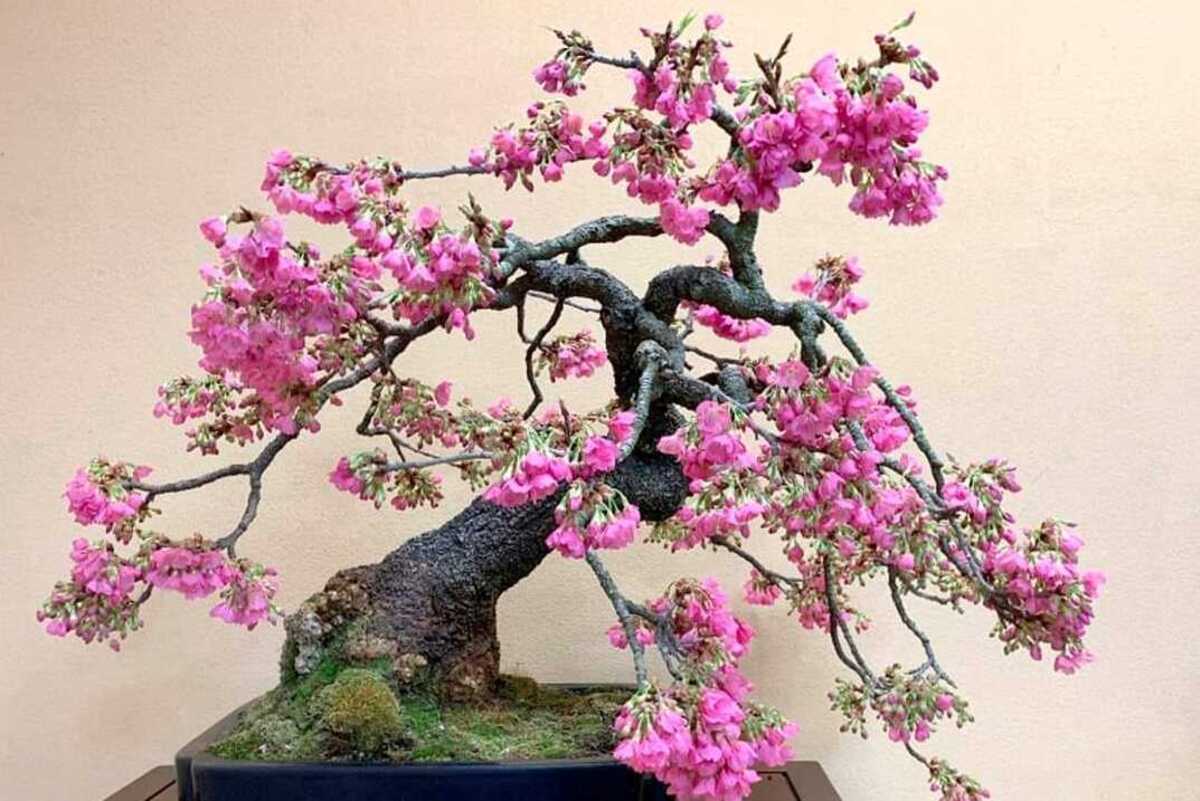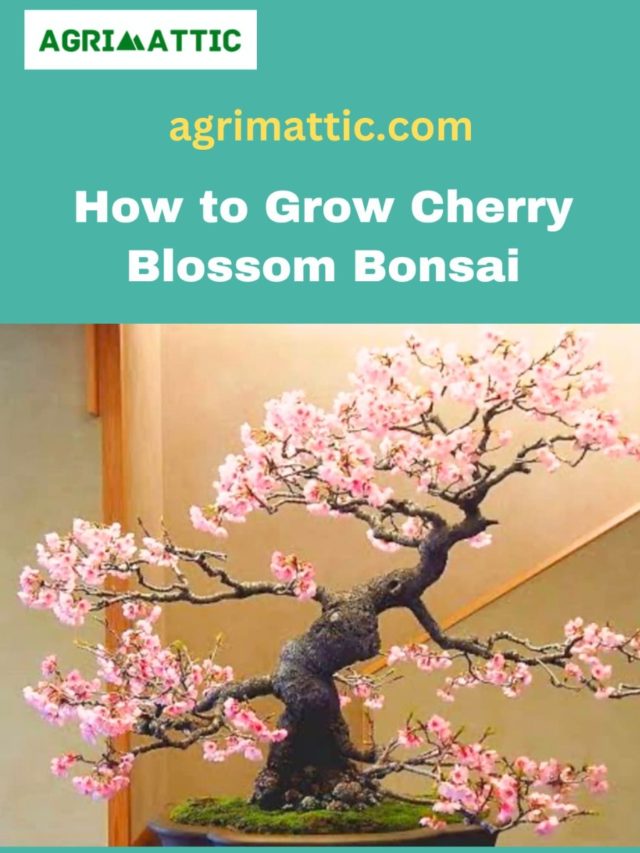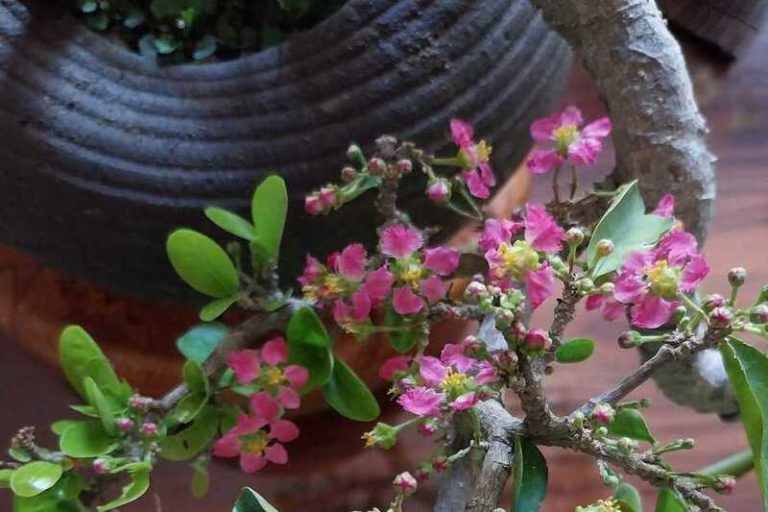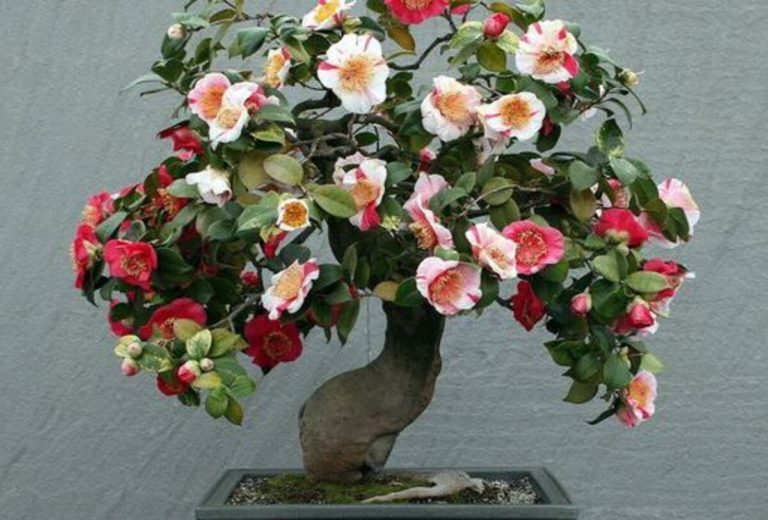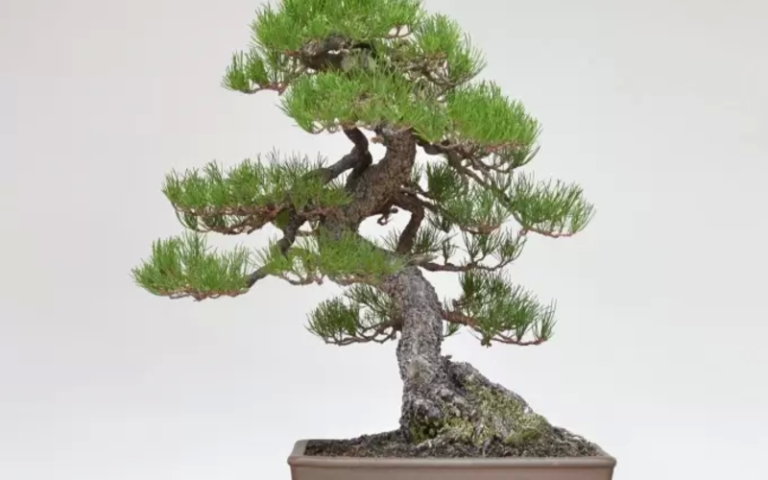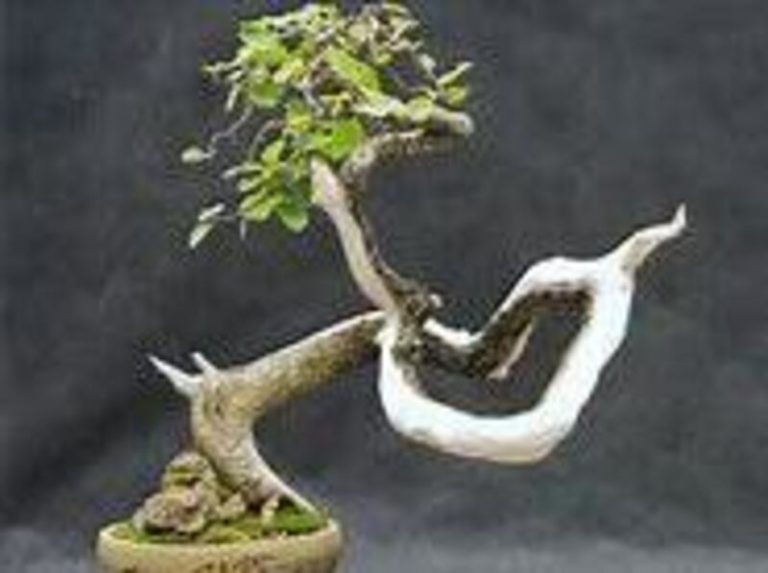Cherry Blossom Bonsai : A Blossoming Symphony in Miniature
A cherry blossom bonsai may be grown in your house and is similar to a work of art created by nature. These little trees are highly significant to culture and have a deep history, along with lovely pink blossoms. We’ll go into the realm of cherry blossom bonsai in this article, offering beginner-friendly instructions.
What is Cherry Blossom Bonsai?
Cherry Blossom Bonsai is the practice of growing tiny cherry blossom trees using the old Japanese art of bonsai. It takes a lot of care and shaping of these trees to get a smaller version of the beauty of their famous pink or white flowers. The objective is to make a living piece of art that represents how short life is and shows how people and nature can live together in peace. Plant lovers use certain types, pots, and gardening methods to keep these little trees healthy and looking nice.
History and Origins of the Cherry Blossom Bonsai
The Cherry Blossom Bonsai has a long and interesting past that goes back to Japanese culture and the old art of bonsai cultivation. Here’s a brief overview:
Bonsai is the art of growing small trees. It began in China more than a thousand years ago, and the Japanese eventually took it up and made it popular. Through careful trimming, shaping, and cultivation methods, they made it popular world wide.
Cherry blooms, which are called “sakura” in Japanese, have been very important to Japanese culture for a very long time. The short-lived beauty of cherry blossoms is a reminder of how short life is and how important it is to enjoy the present. People enjoy the cherry blossom season, which is called “hanami,” in events and get togethers.
Since Japanese culture holds a lot of respect for cherry blossoms, adding them to the bonsai practice makes sense. People who like bonsai wanted to catch the spirit of cherry blossoms in miniature, so they added certain types of cherry blossom trees to their collections.
Cherry Blossom Bonsai is more than just a form of gardening; it shows a deep cultural respect for nature and the ability to show beauty in a small area. The careful shaping and caring of these tiny trees is meant to make a controlled environment that looks like a wild forest with cherry blossoms.
Over time, growing Cherry Blossom Bonsai has become famous outside of Japan and is now also popular in many places around the world. Bonsai fans all over the world enjoy the task of growing these small trees and value not only their beauty but also the cultural and spiritual meanings they hold.
Cherry Blossom Bonsai has a long history that goes back to the Japanese art of bonsai and the deep cultural meanings that are connected to cherry blossoms.
The art form captures the fleeting beauty of these flowers so well in tiny, making it an important and treasured part of bonsai culture.
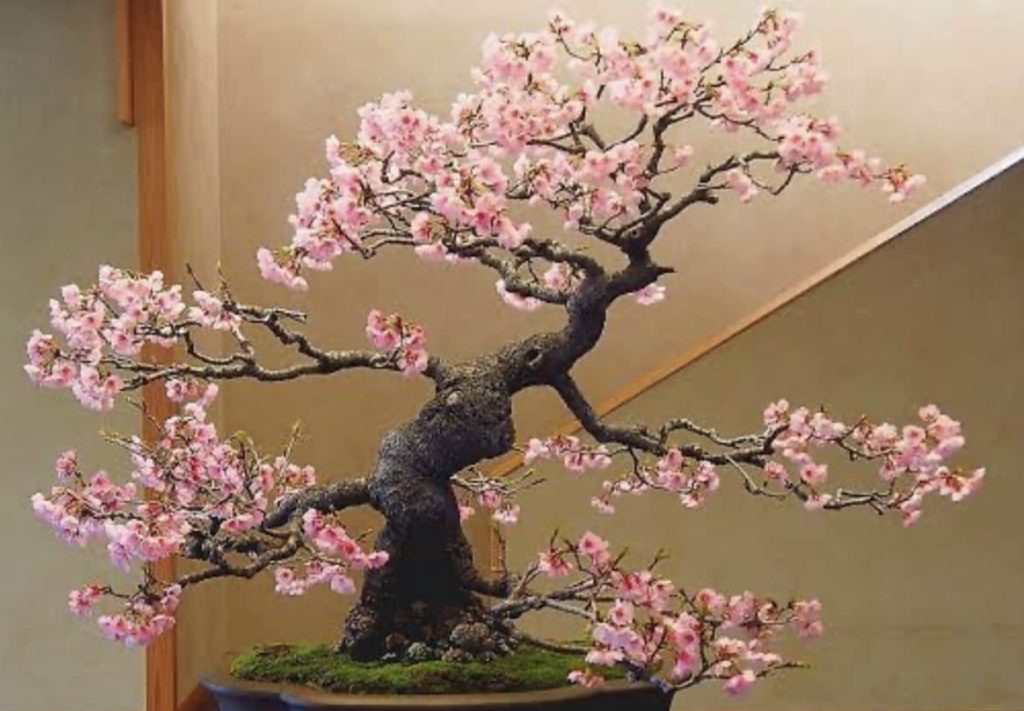
Cherry Blossom Bonsai and Their Symbolism
Cherry Blossom Bonsai is a beautiful example of both the cultural importance of cherry blossoms in Japan and the skill required to grow bonsai. Here are the most important symbols that are linked to Cherry Blossom Bonsai:
1. Transience and Impermanence:
People love cherry flowers for their short but beautiful growing season. The flowers’ short lives are a metaphor for how short life is and how important it is to enjoy every moment. When it comes to Cherry Blossom Bonsai, the small trees represent this meaning and remind fans of the beauty in things that change.
2. Renewal and New Beginnings:
The blooming of cherry trees signifies the start of the spring season, serving as a symbolic representation of rejuvenation and the potential for fresh starts. The meaning of Cherry Blossom Bonsai can be seen by its cyclical patterns of development and blooming throughout the seasons.
3. Beauty and Elegance:
Beautiful and classy, cherry blossoms are admired for their allure. Cherry Blossom Bonsai tries to bring this beauty to life on a smaller scale, showing off the extreme skill needed to shape and care for these tiny trees. Bonsai’s beauty serves as a reminder of how beautiful nature really is.
4. Cultural Heritage:
In Japanese society, cherry blossoms are very important symbols. They stand for beauty, grace, and how short life is. These cultural values are reflected in cherry blossom bonsai, which connects fans to Japan’s rich history.
5. Harmony with Nature:
Bonsai shows how people and wildlife can live together peacefully. A deeper level of this unity can be seen in cherry blossom bonsai, which uses a tree that is both traditionally and physically important. Making a link with nature through this art form helps people feel balanced and calm.
6. Celebration and Festivity:
There is a lot of joy and celebration in Japan during hanami (cherry blossom watching) season when the cherry blossoms bloom every year. This joyful mood can be brought into homes and parks with Cherry Blossom Bonsai, so fans can enjoy the beauty of cherry blooms all year long.
Cherry Blossom Bonsai is more than just a hobby for gardeners; it’s a way to experience the beauty of nature and the deep cultural meanings that Japanese people attach to cherry blossoms. Taking care of and growing these tiny trees turns into a meditative trip that helps you understand how life’s beauty changes over time and how people and nature are linked.
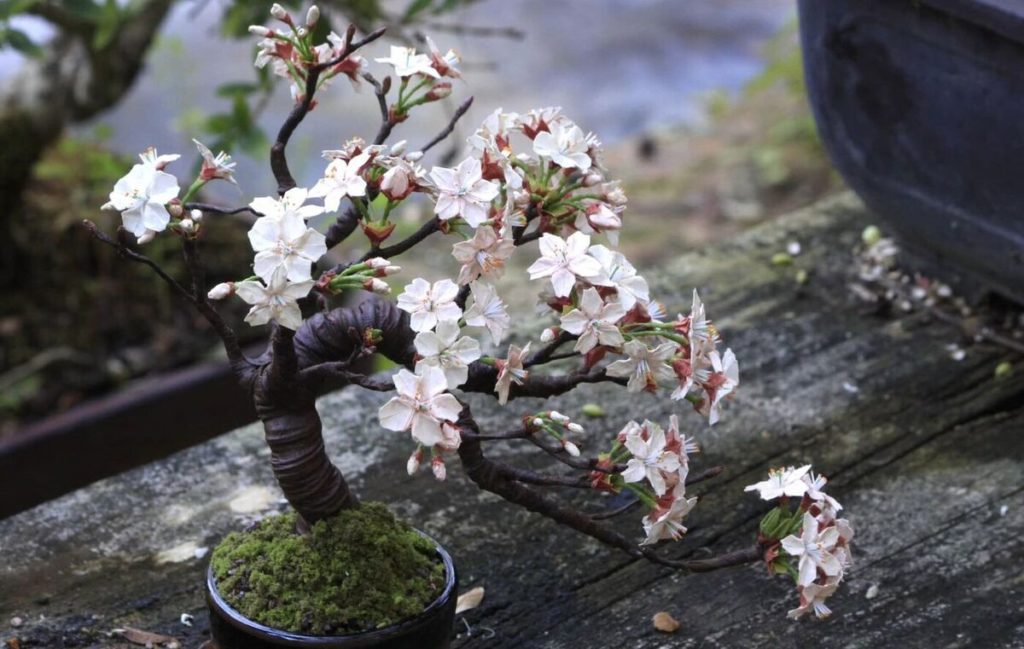
Characteristics of the Cherry Blossom Bonsai
Cherry Blossom Bonsai, which are called “Sakura” in Japan, are beautiful little trees that really draw you in with their delicate beauty. Some of these characteristics are:
Flowering: Cherry blossom bonsai plants grow small, delicate flowers that look like cherry blossoms. These flowers usually come in pink or white and make a beautiful show in the spring.
Size: Their height ranges from 6 inches to 36 inches, which makes them great for bonsai gardens both inside and outside.
Branches and a trunk: For cherry blossom bonsai, the stems often look old because the bark is rough and the branches are twisted and knotted. This gives the trees a graceful and natural look over time.
Leaves: During the growth season, the leaves turn bright green and are usually small and oval-shaped. They may change to shades of yellow, orange, or red in the fall before dropping.
Care: To keep a Cherry Blossom Bonsai healthy, it needs to be watered regularly, get enough sunlight, be pruned, and go through fertilization. Additionally, they need to be kept warm during the winter in colder places.
Symbolism: Cherry blossoms are a sign of the passing of time, the splendor of nature, and the arrival of spring in Japanese culture. They are linked to rebirth and the transient aspect of life, and they have great cultural value.
Aesthetic Value: People really like these trees because they look so beautiful, especially when they bloom. Many people think that the difference between the delicate flowers and the bonsai’s small size is stunning and a sign of natural beauty.
Meaning in culture: In Japan, cherry blossom bonsai are an important part of culture and are often displayed at events like Hanami, which honors the beauty of cherry blossoms. There are also works of art, literature, and traditional rituals that honor and praise their beauty.
Remember that to grow and care for a cherry blossom bonsai properly, you need to be dedicated, patient, and know exactly what to do.
How to Grow Cherry Blossom Bonsai
Growing a cherry blossom bonsai can be fun and satisfying, but you have to be patient and pay close attention to every detail. Here are some steps to grow a pretty Cherry Blossom Bonsai:
1. Choosing the Right Cherry Blossom Tree:
- Select an appropriate species of cherry blossoms for bonsai. Wild cherry (Prunus avium) and Japanese cherry (Prunus serrulata) are two well-liked varieties.
- Choose a tree that has clear stem and a unique shape. Consider about how big the tree is and whether it will be able to grow indoors or outdoors.
2. Choosing the Right Pot:
- Bonsai trees need a shallow pot so that their roots don’t grow too much and they look small. Pick a pot with good drainage holes to keep the soil from getting too wet.
3. Soil and Repotting:
- Use bonsai soil that drains well to help roots grow in a healthy way. Every two to three years, move your cherry blossom bonsai to a new pot to clean the soil and trim the roots.
4. Watering:
- A moderate level of moisture is ideal for cherry blossom bonsai trees. Allow the soil to become slightly dry before watering the tree, but prevent it from drying completely. To prevent soil disturbance, utilize an irrigation can equipped with a fine nozzle.
5. Lighting:
- There should be a lot of sunlight for cherry blossom bonsai trees. As long as your tree gets at least 6 to 8 hours of sunshine every day, it’s healthy. Using grow lights to add natural light is a good idea if you are growing it indoors.
6. Temperature and Humidity:
- In order to replicate their natural dormancy period, cherry blossom trees generally favor lower winter temperatures. The growing season, however, requires warmth as well. 50–75°F (10–24°C) should be the maintained temperature range.
- It’s important to have enough oxygen, especially if you’re growing the bonsai inside. You can use a humidity box or put a tray with water and rocks next to the bonsai to raise the humidity.
7. Pruning and Training:
- To keep your cherry blossom bonsai’s shape and size, you need to prune it often. Cut back in late winter or early spring, before new growth starts to show.
- Use wire to bend the twigs into the shape you want. Be gentle so you don’t hurt the trees.
8. Fertilizing:
- During the growth season (spring and summer), use a balanced, water-soluble fertilizer to give your plants the nutrients they need. During the fallow season (fall and winter), fertilize less or not at all.
9. Disease and Pest Control:
- Watch out for bugs like aphids, spider mites, and scale insects. Take the right steps right away to get rid of any bugs. For plant diseases to stay away, make sure there is enough air flow around the tree.
10. Patience and Observation:
- Bonsai is a craft that needs a lot of care. Keep an eye on your tree and make changes as needed. Have fun taking care of and shaping your cherry blossom bonsai.
Keep in mind that every bonsai is different, and the care needs may also be different depending on the type of cherry blossom tree you have. Make sure you care for your bonsai in a way that meets its needs, and enjoy the process of turning a small tree into a work of art.
Displaying and Showcasing the Cherry Blossom Tree
Putting your cherry blossom bonsai on display is an important part of enjoying its beauty. Here are some suggestions on how to best show off your cherry blossoms bonsai:
1. Selecting a Display Stand:
- Choose a bonsai stand or show table that looks good. The stand should match the style of your cherry blossom bonsai and make it look better.
2. Choosing the Right Pot:
- The pot is an important part of the show. Pick a pot that goes with the style and color of the tree. Earth tones are a good choice most of the time, but you can pick any color that you like and fits with the theme of the show.
3. Arranging with Accent Items:
- To improve the general show, think about adding accents like small stones, moss, or figurines. These things can help make the bonsai setting feel more natural and peaceful.
4. Placing in a Prominent Location:
- Simply put your cherry blossom bonsai somewhere that it can be enjoyed. Select a location that gets a lot of natural light and lets people see the tree from different views, whether it’s inside or outside.
5. Using Bonsai Shelves or Displays:
- You might want to use bonsai shelves or a show table with different levels if you have a small collection or a lot of bonsai trees. With this layout, you can make something that looks good.
6. Seasonal Displays:
- Make the most of the changing seasons. When your cherry blossom tree is in bloom, make it the center of your show. You could add seasonal decorations or other things that go with the flowers.
7. Rotate the Display:
- Rotate the plant every so often to make sure that all of its sides get the same amount of light. This helps the tree get a form that is balanced and looks good. In addition, it lets people enjoy different parts of the tree over time.
8. Consider a Viewing Stone:
- A viewing stone (suiseki) is often part of traditional bonsai shows. Putting a carefully picked stone next to your cherry blossom bonsai can make it look more balanced and like it’s in a natural setting.
9. Showcasing During Bonsai Exhibitions:
- If you take your cherry blossom bonsai to a bonsai show or event, make sure you follow the rules for how to display it. Presentation is very important, and a bonsai that is shown off well can make a big impression.
10. Photographing Your Bonsai:
- Take pictures of your cherry blossom bonsai to remember how beautiful it is. This lets you keep track of its growth and show off its beauty to other people. To show off its best features, use natural light and try shooting it from different angles.
When you show a cherry blossom bonsai, remember that the goal is to make a balanced and aesthetically pleasing arrangement that brings out the beauty of the tree. Try putting things together and arranging them in different ways until you find a style that suits your taste and the bonsai’s personality.
Styling and Design of a Cherry Blossom Bonsai
For design and style a Cherry Blossom Bonsai, you have to use careful planning to make it look like a real cherry blossom tree. To style and create a Cherry Blossom Bonsai, keep these things in mind:
- Branch Structure:
- It’s important to make sure that the branch structure looks natural and balanced. Like the beauty of cherry trees, you want your design to be open and airy.
- Use trimming tools to shape the branches and cut off any extra growth to keep the overall look balanced.
- Trunk Formation:
- Use wiring methods to make a trunk that is both interesting and expressive. Wiring helps the stem and branches grow in the right direction so that the tree has the shape you want.
- When you wire the stem to make it look good, think about how cherry trees naturally curve and move.
- Blossom Placement:
- Enhance the visual appeal by placing blossoms in an emphasis-worthy manner. To achieve the appearance of fully bloomed cherry blossoms, concentrate flowers along the periphery of branches.
- Wiring and careful cutting can help you control how the flowers are arranged and make sure they are spread out evenly.
- Seasonal Variation:
- Seasonally appropriate design elements for the bonsai. Make appropriate modifications to the arrangement and design in accordance with the season: blooming in the spring, dormant in the winter, or exhibiting blossoms in the spring.
- Think about how the leaves change color with the seasons so that the Cherry Blossom Bonsai can look different times of the year.
- Bonsai Pot and Display:
- Pick a bonsai pot that fits in with the rest of the design. Think about the pot’s color, shape, and size to make it look better.
- For example, you could try displaying the bonsai in creative ways by adding stones, grass, or small artistic items that go well with it.
- Pruning for Shape:
- Pruning the bonsai on a regular basis will help it keep its shape and grow in a healthy way. Make sure that the general design stays cohesive by cutting off any shoots or stems that aren’t needed.
- When you prune cherry flower trees, you’re trying to bring out their natural beauty.
- Harmony and Proportion:
- Aim for balance and unity in the design as a whole. Make sure that the size and arrangement of the stem, branches, and flowers make the composition look good.
- Follow basic bonsai design rules, like the “golden ratio,” to make a Cherry Blossom Bonsai that is balanced and looks good.
- Patience and Adaptation:
- Keep in mind that a Cherry Blossom Bonsai changes shape over time. Be patient and allow the tree to develop its unique character.
- Enjoy the natural beauty of each tree by changing the way it is styled based on its growth patterns and other traits.
A Cherry Blossom Bonsai needs to be styled and designed using artistic skills, careful cutting, and knowledge of how cherry trees naturally grow. The objective is to produce a tiny work of art that reflects the spirit and beauty of cherry blossoms in a way that is both orderly and striking to the eye.
How to Care for and Maintain a Cherry Blossom Bonsai
To care for and maintain a Cherry Blossom Bonsai, you need to pay attention to many things, such as watering, pruning, fertilizing, and the plant’s surroundings. Here is an easy guide to help you take care of and grow your Cherry Blossom Bonsai:
1. Watering:
- Check the soil regularly. When the soil feels almost dry but not quite, add water.
- Make sure that the roots get all the water you give them. Let the extra water drain so that the soil doesn’t get soggy.
- Depending on the season, change how often you water. During the growing season, you’ll usually need more water.
2. Sunlight:
- Put the tree somewhere that gets bright, indirect sunlight. Cherry Blossom Bonsai does better when it gets several hours of sunlight every day.
- Avoid putting the tree in the direct afternoon sun, especially if you live somewhere hot, to keep the leaves from getting burned.
3. Pruning:
- Regular pruning will help the plant keep its shape and size. Pay attention to getting rid of dead or sick twigs and extra growth.
- Remove the dead wood after the flowers have died to help the plant grow new leaves and flowers next year.
4. Soil and Repotting:
- To keep the soil from getting too wet, use bonsai soil that drains well. Every two to three years, usually in early spring, you should repot the bonsai.
- Trim and clean the roots and refill the soil when you repot the plant to give it the nutrients it needs.
5. Fertilizing:
- During the growth season, from spring to early fall, use a balanced bonsai fertilizer that dissolves in water to feed the plant.
- Follow the directions on the fertilizer box for how much to use. During the dormant winter time, fertilization should be cut back or stopped.
6. Temperature and Humidity:
- Keep your Cherry Blossom Bonsai at a reasonable temperature. Temperatures between 50°F and 70°F (10°C and 21°C) are best for most types.
- Make sure there is enough air, especially inside. Mist the tree often or use a humidity tray.
7. Protection from Pests and Diseases:
- Check the tree often for bugs like aphids and spider mites. Use insecticidal soap or neem oil right away to get rid of pests.
- Keep the tree in good health to prevent diseases. Avoid overwatering to prevent root rot.
8. Winter Care:
- Keep the bonsai safe from frost and cold weather in the winter. You might want to move it to a protected area or cover it to keep the frost off.
- Water sparingly during winter dormancy, allowing the soil to partially dry between waterings.
9. Display Considerations:
- A good place for the bonsai is one that gets enough sunlight and looks good with it overall.
- Every so often, turn the bonsai so that it grows evenly on all sides.
10. Observation and Adaptation:
- Pay close attention to what your Cherry Blossom Bonsai needs. Watch how it grows, react to changes, and change how you care for it based on what you see.
To take good care of a Cherry Blossom Bonsai, you need to pay close attention and know what the tree needs. You can enjoy the beauty of cherry blossoms in a small, doable form by making sure it has the right conditions and meeting its unique needs.
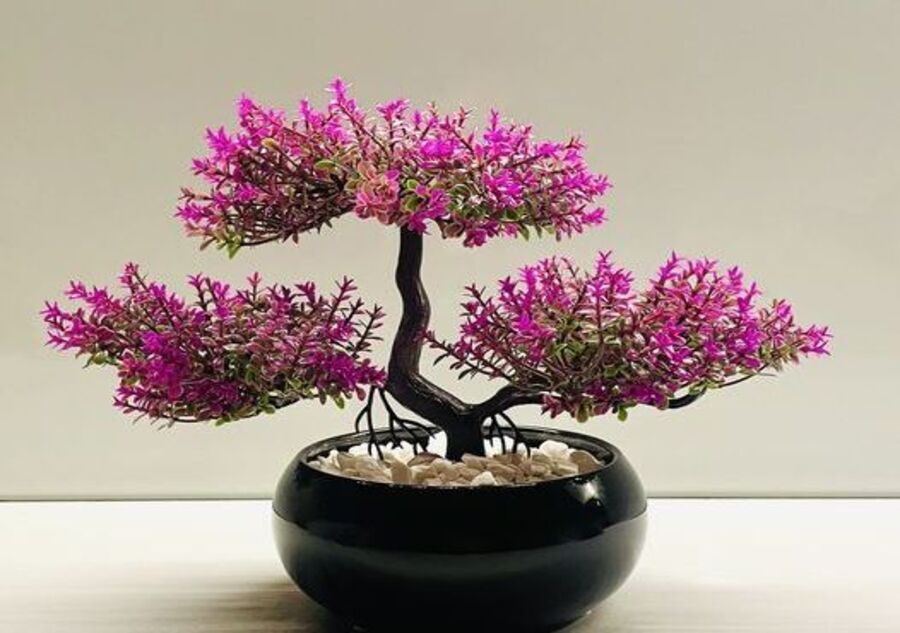
Cherry Blossom Bonsai Care Sheet
| Aspect | Care Tips |
|---|---|
| Watering | Check the soil regularly; water when the topsoil is slightly dry. |
| Water thoroughly, allowing excess to drain. | |
| Adjust frequency based on season; more in the growing season. | |
| Sunlight | Place in bright, indirect sunlight. |
| shield from the harsh afternoon sun, especially in hot climates. | |
| Temperature | – Maintain temperatures between 50 and 70°F (10 and 21°C). |
| Protect from frost and freezing temperatures during the winter. | |
| Humidity | Maintain moderate humidity; use trays or mist regularly. |
| Ensure good airflow around the bonsai. | |
| Fertilization | Use a balanced, water-soluble bonsai fertilizer during the growing season. |
| Follow the recommended dosage; reduce or stop during winter dormancy. | |
| Pruning and Trimming | Regularly prune to maintain shape and remove dead or excessive growth. |
| Prune after the blooming season to encourage new growth. | |
| Wiring and Styling | Use wiring techniques to shape trunks and branches. |
| style for a natural, balanced appearance; consider cherry tree aesthetics. | |
| Repotting | Repot every 2-3 years, typically in early spring. |
| Trim and refresh roots during repotting; use well-draining bonsai soil. | |
| Pest and Disease Control | Regularly inspect for pests like aphids or spider mites. |
| Treat infestations promptly with insecticidal soap or neem oil. | |
| Winter Care | Protect from frost and freezing temperatures. |
| Water sparingly during winter dormancy; allow the soil to partially dry. | |
| Regular Maintenance | Rotate the bonsai periodically for even growth. |
| Observe growth patterns and adapt the care routine accordingly. | |
| General Tips | Keep the tree in good health to prevent diseases. |
| Avoid overwatering to prevent root rot. | |
| display in a location that complements aesthetics and provides adequate sunlight. |
This care sheet is a quick reference for the key elements of taking care of a Cherry Blossom Bonsai. It includes useful tips to keep it healthy and happy all year long.
Conclusion:
It is fun and satisfying to grow Cherry Blossom Bonsai. Giving a small tree the right amount of care and attention can turn it into a beautiful natural piece. Enjoy the peaceful atmosphere that Cherry Blossom Bonsai creates. Enjoy growing!
FAQ
Q: How often should I water my Cherry Blossom Bonsai?
A: Water when the topsoil feels slightly dry; frequency depends on the season, more water needed during the growing season.
Q: Where should I place my Cherry Blossom Bonsai for sunlight?
A: Choose a spot with bright, indirect sunlight and protect it from the harsh afternoon sun.
Q: What temperature is suitable for Cherry Blossom Bonsai?
A: Maintain temperatures between 50 and 70°F (10 and 21°C); protect from frost and freezing temperatures in winter.
Q: How do I fertilize my Cherry Blossom Bonsai?
A: Use a balanced, water-soluble bonsai fertilizer during the growing season, following the recommended dosage, reduce or stop in the winter.
Q: When and how should I prune my Cherry Blossom Bonsai?
A: Regularly prune to maintain shape and remove dead or excessive growth. prune after the blooming season to encourage new growth.
Q: Can I style my Cherry Blossom Bonsai using wiring?
A: Yes, use wiring techniques to shape the trunk and branches, style for a natural, balanced appearance.
Q: How often should I repot my Cherry Blossom Bonsai?
A: Repot every 2-3 years, usually in early spring; trim and refresh roots during repotting using well-draining soil.
Q: How do I control pests and diseases on my Cherry Blossom Bonsai?
A: Regularly inspect for pests like aphids or spider mites. treat infestations promptly with insecticidal soap or neem oil.
Q: What care does my Cherry Blossom Bonsai need in the winter?
A: Protect from frost and freezing temperatures; water sparingly during winter dormancy, allowing the soil to partially dry.
Q: Any general tips for maintaining a healthy Cherry Blossom Bonsai?
A: Keep the tree in good health by avoiding overwatering to prevent root rot; rotate periodically for even growth; observe growth patterns; and adapt the care routine accordingly.
Also Read:

